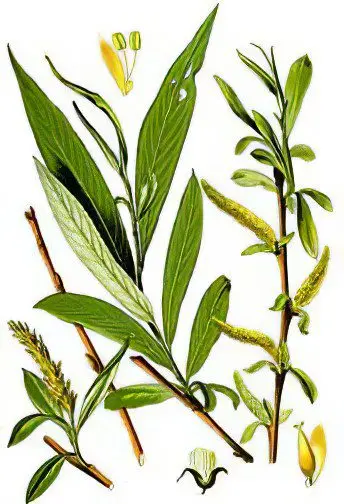Contents
Useful properties and recipes for the use of white willow
Botanical characteristics of white willow

Willow – a tree of the willow family, about 30 meters in height, with a thick trunk. The plant has a beautiful spreading crown with sagging branches. Young trees have a light gray bark, but older trees have an almost black, cracked bark. On the thin yellow branches of the tree there are long silver-silky leaves on short petioles. Small willow flowers are collected in several pieces into earrings, which are of two types: women’s earrings are short and thin, but men’s, on the contrary, are long and cylindrical. Earrings bloom along with the leaves.
Willow fruit is a box consisting of one nest of two wings. Inside the fruit there are many small seeds, on the surface of which there are hairs. Willow blooms in April, and a month later you can observe the ripening of the fruits of the plant.
In the CIS, willow is a very common tree. It can be observed on the edges of forests, near houses and roads, in floodplains and on wet soil. Willow prefers fertile soil.
Useful properties of white willow
The bark and leaves of the plant contain organic acids, tannins, ascorbic acid and flavonoids. Willow has an antipyretic and antiseptic effect on the human body.
For medicinal purposes, the bark of the plant is usually used, but men’s earrings are also used in folk medicine. Willow bark has astringent and anti-inflammatory properties. In addition, willow bark preparations have a choleretic, diuretic, and anthelmintic effect. Infusion and decoction of the bark of the plant help to remove uric acid from the body, which is why they are used for gout and arthritis.
Willow is a plant that takes energy, and in return gives peace and relaxation. With the help of a decoction of white willow, you can remove a headache.
White willow preparations are also used externally. For example, an infusion of the bark of a plant is used for skin diseases, ulcers and sweating of the feet. As a rinse, an infusion of the bark is recommended for inflammation of the oral cavity, nose and pharynx.
Propagation of white willow

Willow is propagated by seeds, cuttings, stem shoots and layering. Sandy soils and moist soil are most suitable for reproduction.
Propagation by cuttings is done as follows. It is necessary to cut the willow branches, support them in water until the roots appear. Once the roots have formed, you can plant the plant in the soil. To get elastic shoots, the process must be watered.
Willow does not need special care. The soil for it should be moist, fertile and fresh. If the time is dry, then the willow needs only some watering and spraying. Spring time is the time for loosening young plants and mulching them with peat. Given the fact that willow responds well to pruning, you can give it a beautiful shape. Branches that are too long or dead should be cut off.
The use of white willow
A decoction of willow bark as an antipyretic. Take 1 tablespoon of the bark of the plant and grind it. Pour the raw material with a glass of boiling water and put on a small fire for 20 minutes. The decoction is ready. After straining, you can take 1 tablespoon three times a day.
A decoction of willow for prostatitis. To prepare it, you need to take 1 tablespoon of willow branches and finely chop them. Pour the chopped branches with 200 ml of boiling water. Put on fire for 5 minutes. After straining, take 100 ml three times a day.
Willow medicine for removing warts. Take the ashes from willow wood and add table vinegar to it. The result should be a mass that looks like gruel. This gruel is applied to the warts until they dry out and begin to fall off.
Decoction of willow for hair loss. Take 1 tablespoon of willow bark and the same amount of burdock roots and pour all 500 ml of water. Put in a water bath for 20 minutes and leave for about two hours. After straining the finished broth, they need to wash their hair no more than twice a week.
Willow remedy for goiter. Take willow shoots and burn them. Coals from burning must be ground and mixed with honey. The mixing ratio is 1 part coal to 2 parts honey. The finished product is taken 3 times a day 20 minutes before meals. A single dose of admission is 50 grams.
Tincture for tachycardia and arrhythmias. It is necessary to take 100 grams of male willow inflorescences, pour them with 500 ml of vodka and leave to infuse for 1 month. The finished tincture is taken 30 or 35 drops no more than four times a day before meals. But before taking a drop of tincture, you need to dilute it with a spoonful of water.
Contraindications to the use of white willow
With bradycardia, preparations from willow flowers should not be used. Willow-based medicines should not be used by children under the age of 16 with flu or cold symptoms. The ban is due to the fact that due to taking preparations from willow, which contain salicylates, the child may develop Reye’s syndrome, a disease that can lead to the death of the child. Ulcers should also not use willow remedies.









